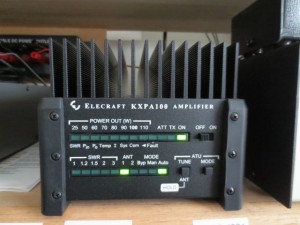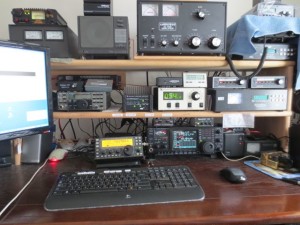I am a little late getting this posted because I have been busy setting my station up for RTTY operation (a new mode for me) for the NAQP RTTY contest.
However, last week I received the Elecraft KXPA-100 amplifier which was backordered at the time I ordered the KX3. The KXPA100 is a compact 100 watt amplifier designed to boost the QRP signal from the KX3 up to the 100 watt level of a standard transceiver. It is primarily designed for those wanting to use the KX3 as both a portable QRP rig and a primary home transceiver.
The KXPA100 when inter-connected to the KX3 using the CAT 5 interface cable will work seamlessly with the KX3. Once the KX3 and KXPA100 are connected all of the functions of the KXPA100 are controlled from the KX3; including the amplifier on/off, band changes, antenna tuner and output power adjustment. When the KX3 power is increased above 10 watts the KXPA100 kicks in. When the power is set below 10 watts the KXPA100 is internally bypassed. The optional internal antenna tuner (located in the KXPA100) will automatically track and adjust with band changes. Like most automatic antenna tuners it contains memories that remember the settings per frequency segment and antenna selected (Ant 1 or 2). If the tuner does need to re-tune the process takes just a few seconds. The turner is wide ranged and should be able to match any reasonable antenna.
I wanted to give the new KX3 and KPA100 a try so I decided to make a few contacts during the ARRL CW DX contest last weekend. I had only planned to make 90 to 100 contacts but once I started, I was having so much fun with the KX3 that I found it hard to quit.
The KX3 is a marvelous CW rig. When combined with the KXPA100 it is a near perfect CW contest rig. I found it’s CW operation more enjoyable than my Icom 756 Pro III. The KX3’s receiver is very quiet and does an extraordinary job separating strong signals that are copious during contest operation. I didn’t experience any receiver de-sensing by strong adjacent signals as I sometimes do with the Icom 756 Pro III. I’m not putting Icom 756 Pro III down because it also does a great job in crowded band conditions, the KX3 with it’s roofing filter and latest generation DSP outperformed the 756 Pro III in my hands on testing.
Here is a summary of my results:
ARRL CW DX Contest – ALL Band, Low Power, Assisted (S&P)
| Band | QSOs | Points | Countries |
| 40m | 46 | 138 | 25 |
| 20m | 110 | 327 | 46 |
| 15m | 94 | 282 | 43 |
| 10m | 126 | 378 | 49 |
| Total | 376 | 1125 | 163 |
Total Score: 183,375
73,
Fred, KC9QQ



